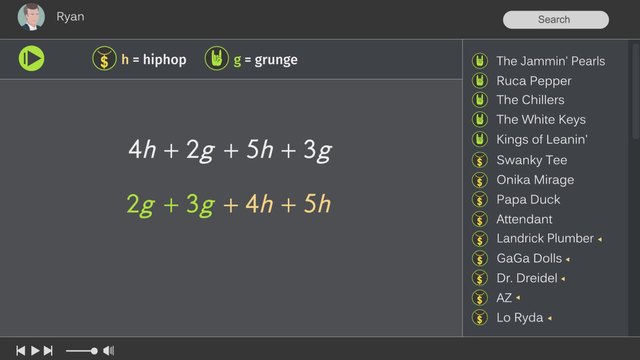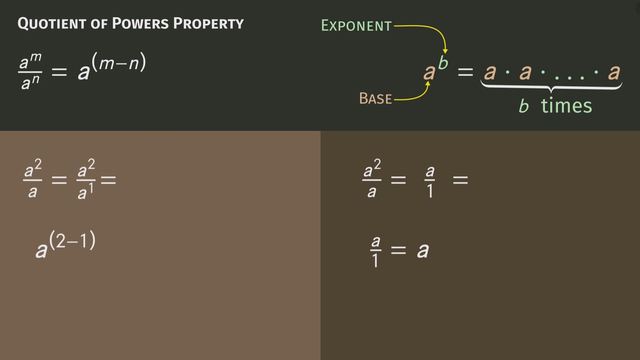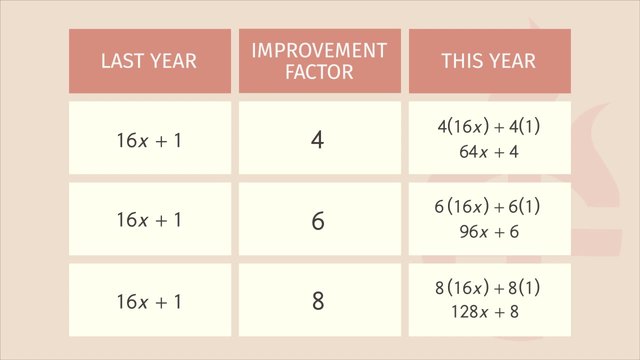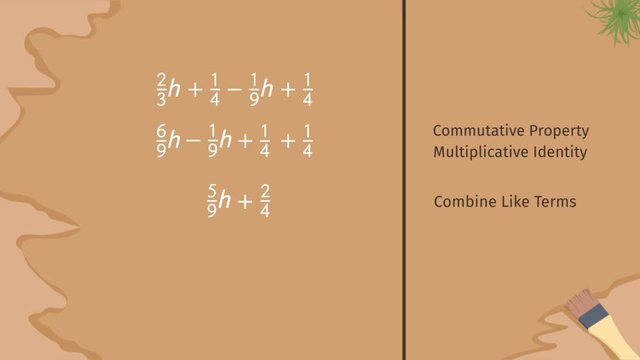Using the Identity and Inverse to Write Equivalent Expressions
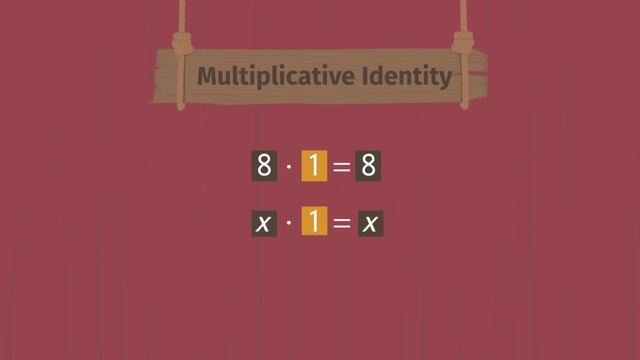

Basics on the topic Using the Identity and Inverse to Write Equivalent Expressions
When performing arithmetic operations on real numbers, it’s important to know about additive identities, multiplicative identities, the additive inverse, and the multiplicative inverse. Adding a number to its additive inverse will always result in the additive identity, zero, while multiplying a nonzero real number by its multiplicative inverse will always result in the multiplicative identity, one. Learn about additive and multiplicative inverses and identities by watching Mr. Magic and his assistant, Vanna, perform magic tricks to amaze a crowd. Common Core Reference: CCSS.MATH.CONTENT.7.EE.A.1
Transcript Using the Identity and Inverse to Write Equivalent Expressions
Mr. Magic has been practicing his tricks in private and is quite sure that he will be loved by the public. Today is his first show, and he’s joined by his assistant, Vanna. Little does the audience know...that Mr. Magic will be Applying the Identity and Inverse Properties in his tricks. For his first trick, Mr. Magic’s going to increase the number of rabbits. He has five to start with. Then he does his trick and poof!!! Mr. Magic’s lack of talent means that he’s been able to add zero new rabbits. The crowd boos and throws tomatoes at him.
So, what is 5 + 0? It’s 5, of course. If you add zero to any number, the number stays the same. Zero is the additive identity. The Additive Identity just means that any number will always stay the same if you add zero to it. For his next trick, Mr. Magic takes one of the tomatoes that was thrown at him. He’s going to make it into a giant tomato or so he says. At the moment, it weighs 8 ounces. He waves his wand and now it's bigger by a factor of 1! So how much does it weigh now? 8 x 1 is 8. Actually, any number multiplied by one is the same number. One is the multiplicative identity. Similar to the additive identity you just learned, the multiplicative identity states that any number will always stay the same if multiplied by 1. Mr. Magic leaves the stage, disappointed at how little the audience appreciated his amazing magic involving the additive and multiplicative identities. His assistant, Vanna, decides to continue the show, doing the opposite of Mr. Magic. She brings back the rabbits. This time she takes the 5 rabbits and makes 5 of them disappear with a wave of the wand. There aren’t any left! The crowd cheers loudly! Five minus five equals zero. -5 is the Additive Inverse of 5. The Additive Inverse of a number is the number that you must add to that number in order to get zero. If you take any positive number and add the negative of that number, you will always get zero. Similarly, if you take any negative number and add the positive of that number, the answer will always be zero. Vanna takes the same tomato that Mr. Magic worked his magic on. She tells the audience that she’s going to shrink it by a factor of eight. She waves her wand, and boom, it’s now a tiny cherry tomato. The crowd goes wild! And how much does it weigh? Eight times one eighth equals one. One eighth is the Multiplicative Inverse of 8, because the product is one. The Multiplicative Inverse of a number is the number you must multiply by to get 1. If any number 'x' is given, the Multiplicative Inverse is one over that number, because, as you can see, the product is one. Dejected, Mr. Magic plods back home if only he could think of magic tricks audiences would want to see...
Using the Identity and Inverse to Write Equivalent Expressions exercise
-
Describe the additive and multiplicative inverses and identities.
HintsSolve the following equation:
$\begin{array}{rcl} x+5 & = & ~0\\ \color{#669900}{-5} & &\color{#669900}{-5}\\ x & = & ~-5 \end{array}$
Solve the equation $8\times x=1$.
SolutionWe are interested in the identity and inverse for addition and for multiplication:
Let's start with addition:
Which number can you add to any other number without changing the number? It's $0$, or the additive inverse.
For example, $5+0=5$.
In general, we have $x+0=x$ for any given $x$. This means that no matter which number you add zero to the sum is the number itself.
The other way around we get the additive inverse: the number you have to add to a given number to get zero.
We can see that $5-5=0$. We can write this as an addition of two numbers too: $5+(-5)=0$. So, $-5$ is the additive inverse of $5$.
Generally $-x$ is the additive inverse for a given number $x$:
- $x+(-x)=0$
- $(-x)+x=0$
The multiplicative identity is the number $1$. No matter which number you multiply by $1$ the product is the number itself. For example, $8\cdot 1=9$, or in general $x\cdot 1=x$.
The other way around: the multiplicative inverse of a given number is the number you have to multiply the given number by to get $1$. Let's have a look at an example:
$8\cdot \frac 18=1$.
We can generalize it for a given non zero number $x$: $x\cdot \frac1x=1$.
-
Determine which statements are true.
Hints- The additive identity is $0$.
- The multiplicative identity is $1$.
Just look at the following examples:
- $4+(-4)=0$
- $7+0=7$
- $8\times 1=1\times 8=8$
- $7\div 7=1$
SolutionHere you have a few statements concerning the additive as well as multiplicative identity and inverse.
If you add one rabbit to five rabbits the sum is five rabbits. We have that $5+1=6$. So, this statement is false.
You can add zero to any given number without changing this number. Let any given number be represented by $x$, so you get $x+0=x$. This is true.
The additive inverse of $5$ is $-5$. In general, the additive inverse of any given number $x$ is $-x$, so this statement is true.
If you add any number to its additive inverse you get the multiplicative identity. Let any number be $x$. Then the additive inverse of $x$ is $-x$. Adding these two numbers together, we get $x+(-x)=0$. As $0$ is not the multiplicative identity, but rather the additive identity, this statement is false.
If you add any number to its additive inverse you get the additive identity. For any number $x$, we have $x+(-x)=0$. This statement is true because $0$ is the additive identity, not the multiplicative one.
Multiplying any number by zero leads to the number itself. This is a false statement. If you multiply any number by $0$ the product is $0$.
If you divide any number by itself you get the multiplicative identity. Dividing any non zero number by itself can be written as $\frac xx=x\times \frac1x=1$. So, this statement is true.
-
Decide which inverse or identity is being applied to $x$ in the equation.
HintsThe result of adding or multiplying by the inverse is the corresponding identity.
- The additive identity is $0$.
- The multiplicative identity is $1$.
Here you see some examples:
- $1+0=1$ ... for the additive identity
- $2+(-2)=0$ ... for the additive inverse
- $3\cdot 1=4$ ... for the multiplicative identity
- $4\cdot \frac14=1$ ... for the multiplicative inverse
SolutionLetting $x$ be any number, we have that:
- The additive identity is $0$, so $\rightarrow$ $x+0=x$.
- The additive inverse of $x$ is $-x$, so $\rightarrow$ $x+(-x)=0$.
- The multiplicative identity is $1$, so $\rightarrow$ $x\cdot 1=x$.
- The multiplicative inverse of $x\neq 0$ is $\frac1x$, so $\rightarrow$ $x\cdot \frac1x=1$.
-
Identify which inverse or identity $x$ represents for each equation.
HintsHere is an example of using the additive identity: $7+0=7$.
An example of using the additive inverse is $7+x=0$.
Here, we have that $x=-7$.
The solution to the equation $14\times x=14$ is the multiplicative identity $x=1$.
SolutionKeep the following in mind:
- The additive identity is $0$ $\rightarrow$ $x+0=x$
- The additive inverse of $x$ is $-x$ $\rightarrow$ $x+(-x)=0$
- The multiplicative identity is $1$ $\rightarrow$ $x\times 1=x$
- The multiplicative inverse of $x\neq 0$ is $\frac1x$ $\rightarrow$ $x\times \frac1x=1$
The additive identity:
- $28+x=28$
- $12+x=12$
- $5+x=0$
- $x+11=0$
- $12\times x=12$
- $2\times x=2$
- $3\times x=1$
- $5\times x=1$
-
Find the right identity or inverse needed to make the equation true.
HintsWrite a fraction $\frac 12$ as follows $1\div 2$.
The additive identity is $0$ and the multiplicative identity is $1$.
For any given number $x$ the additive inverse is $-x$ and, if $x\neq 0$, the multiplicative inverse is $\frac 1x=1\div x$.
SolutionKeep the following in mind:
- The additive identity is $0$.
- The multiplicative identity is $1$.
- The additive inverse of any given number $x$ is $-x$. Just change the sign.
- The multiplicative inverse of any non zero number $x$ is $\frac1x=1\div x$, the reciprocal.
- $5+(\mathbf{-5})=0$
- $3\times(\mathbf{1\div 3})=1$
- $4+(\mathbf{0})=4$
- $7\times(\mathbf{1})=7$
- $4+(\mathbf{-4})=0$
- $13\times(\mathbf{1\div 13})=1$
-
Recall the definitions of additive identity, multiplicative identity, additive inverse, and multiplicative inverse.
HintsKeep the following generalization in mind:
- The additive identity is $0$ $\rightarrow$ $x+0=x$
- The additive inverse of $x$ is $-x$ $\rightarrow$ $x+(-x)=0$
Let's have a look at few examples:
- $3+0=3$
- $3+(-3)=0$
- $3\times 1=3$
- $3\times \frac13=1$
SolutionThe additive identity is $0$ $\rightarrow$ $x+0=x$. You can add $0$ to any given number and the sum is always $x$ itself.
The additive inverse of $x$ is $-x$ $\rightarrow$ $x+(-x)=0$.
The multiplicative identity is $1$ $\rightarrow$ $x\times 1=x$. You can multiply any given number by $1$ and the product is the number itself.
The multiplicative inverse of $x\neq 0$ is $\frac1x$ $\rightarrow$ $x\times \frac1x=1$.


